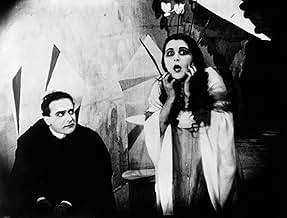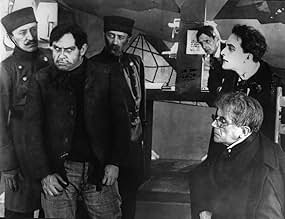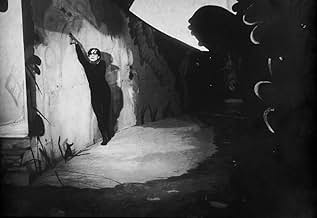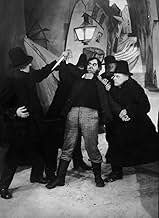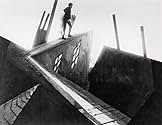NOTE IMDb
8,0/10
74 k
MA NOTE
L'hypnotiseur Dr Caligari utilise un somnambule, Cesare, pour commettre des meurtres.L'hypnotiseur Dr Caligari utilise un somnambule, Cesare, pour commettre des meurtres.L'hypnotiseur Dr Caligari utilise un somnambule, Cesare, pour commettre des meurtres.
- Réalisation
- Scénario
- Casting principal
- Récompenses
- 2 victoires et 1 nomination au total
Friedrich Feher
- Franzis
- (as Friedrich Fehér)
Hans Heinrich von Twardowski
- Alan
- (as Hans Heinz v. Twardowski)
Rudolf Lettinger
- Dr. Olsen
- (as Rudolph Lettinger)
Rudolf Klein-Rogge
- Ein Verbrecher
- (non crédité)
- …
Hans Lanser-Ludolff
- Ein Alter Mann
- (non crédité)
- …
Henri Peters-Arnolds
- Ein Junger Arzt
- (non crédité)
- …
Ludwig Rex
- Ein Mörder
- (non crédité)
- …
Elsa Wagner
- Die Wirtin
- (non crédité)
- …
Avis à la une
I vowed to see more horror films this year, and this was recommended to me, initially I was a little dubious with it being a hundred plus years old, and a silent film, but I have to say I have a real appreciation for it.
Without a doubt, this film must be the inspiration for the whole horror genre, a genre that scares and shocks people to this day, you can only I shine the profound effect that this film must have had on viewers back in its time.
Hugely atmospheric and creepy, if I'm honest, it is slow, and you do need to concentrate, or you'll lose it, no texting or phone play, it is a fairly intense watch, best of all is the ending, which really does come as a surprise, it's something of a twist.
It is definitely not for everyone, and if you're used to modern horror, you may find ten minutes of it an arduous task, but having watched Nose earlier in the year, I have a real appreciation for this early gem.
An admirable film, 8/10.
Without a doubt, this film must be the inspiration for the whole horror genre, a genre that scares and shocks people to this day, you can only I shine the profound effect that this film must have had on viewers back in its time.
Hugely atmospheric and creepy, if I'm honest, it is slow, and you do need to concentrate, or you'll lose it, no texting or phone play, it is a fairly intense watch, best of all is the ending, which really does come as a surprise, it's something of a twist.
It is definitely not for everyone, and if you're used to modern horror, you may find ten minutes of it an arduous task, but having watched Nose earlier in the year, I have a real appreciation for this early gem.
An admirable film, 8/10.
This picture is a masterpiece ! How could someone think in something like this at that time ? The film has really good casting ! Werner Krauss is excellent playing Doctor Caligari and Conrad Veidt (Cesare) too !
This movie has an obscure and bizarre mood makes the film looks really scary sometimes ... The painted scenario gave the film the touch that it needed ! It puts you in a nightmarish world , gives you the sensation of claustrofobia , depression and madness ! The objects have a strange shape and an irregular geometry that collaborate for the maintenance of the dark mood !
But the most important thing in this motion picture is the open ended story ! You´re never sure about the end ! It has so many ways of interpretation... It´s useless to try to define "one end" to this movie. You´ll be always asking yourself about the legitimacy of the man´s vision of the story.
It´s not scary , just sometimes , as I said. But it´s dark and it uses the shadows and lights effects so well that I was amazed the first time I saw and I still amazed ! German Films of that time were really good !
Congratulations to Robert Wienne and his cast ! It´s a masterpiece of madness and paranoia!
Rating : *****/******
This movie has an obscure and bizarre mood makes the film looks really scary sometimes ... The painted scenario gave the film the touch that it needed ! It puts you in a nightmarish world , gives you the sensation of claustrofobia , depression and madness ! The objects have a strange shape and an irregular geometry that collaborate for the maintenance of the dark mood !
But the most important thing in this motion picture is the open ended story ! You´re never sure about the end ! It has so many ways of interpretation... It´s useless to try to define "one end" to this movie. You´ll be always asking yourself about the legitimacy of the man´s vision of the story.
It´s not scary , just sometimes , as I said. But it´s dark and it uses the shadows and lights effects so well that I was amazed the first time I saw and I still amazed ! German Films of that time were really good !
Congratulations to Robert Wienne and his cast ! It´s a masterpiece of madness and paranoia!
Rating : *****/******
10clurge-2
Like so many of the films from the silent era, The Cabinet of Dr. Caligari gets overlooked (if you can even find it!) for big budget duds, and runny romantic comedies. Directors of the period like Griffith, Lang, Eisenstien, and Caligari's Wiene, are never given the credit they deserve. And if credit is given, it is in small cultish circles in various pockets around the world.
The set design here is amazing, not a single right angle can be found in any one of the sets. This may not only apply to the disjointed and distorted characters in the film, but also the state of Germany at the time. After all, the film was made in the dark ages in Germany between WWI and WWII. This point is validated by Siegfried Kracauer, with his notion of how the main character of Dr. Caligari can be easily interpreted to Hitler, and vice versa. Both controlled subjects with a form of "brainwashing", both were upset with current forms of society and government, and both were masters of deception. In a period where Germans were looking for direction, and let's face it, authority as well, Dr. Caligari embodied it fully.
In the area of the players, all the names in the film turn out a literally "speechless" performance. Dagover, Krauß, and especially Veidt as Cesare (pronounced Chez-a-ray) are excellent in the use of gestures and motion to get their point across without using words. The camera, stationary as in most early features, uses the mise-en-scene effectively, letting us identify with characters such as Francis and Jane, and disjointing us from Caligari, and the Criminal.
The use of lines and stripes, not only in the sets but in small places like in the good doctor's hair and on his gloves, adds to the telling of the character. Colour tints of the B&W film also play a special part in bringing the whole film together. An amazing sequence where Caligari reveals his true madness, pits Caligari stumbling through the unequal streets of Germany while being haunted by textual ramblings written in the air. A marvelous achievement for it's time. And it adds so much.
The Cabinet Of Dr. Caligari has changed the way I look at horror films, and even films in general. I urge anyone reading this to pick up this film. The DVD offering is utterly fantastic with the restored print, an audio essay of the film, and production notes. Bypass the overblown "motion picture events of the year", and pick up Caligari, quite possible the greatest motion picture event in the history of motion pictures.
The set design here is amazing, not a single right angle can be found in any one of the sets. This may not only apply to the disjointed and distorted characters in the film, but also the state of Germany at the time. After all, the film was made in the dark ages in Germany between WWI and WWII. This point is validated by Siegfried Kracauer, with his notion of how the main character of Dr. Caligari can be easily interpreted to Hitler, and vice versa. Both controlled subjects with a form of "brainwashing", both were upset with current forms of society and government, and both were masters of deception. In a period where Germans were looking for direction, and let's face it, authority as well, Dr. Caligari embodied it fully.
In the area of the players, all the names in the film turn out a literally "speechless" performance. Dagover, Krauß, and especially Veidt as Cesare (pronounced Chez-a-ray) are excellent in the use of gestures and motion to get their point across without using words. The camera, stationary as in most early features, uses the mise-en-scene effectively, letting us identify with characters such as Francis and Jane, and disjointing us from Caligari, and the Criminal.
The use of lines and stripes, not only in the sets but in small places like in the good doctor's hair and on his gloves, adds to the telling of the character. Colour tints of the B&W film also play a special part in bringing the whole film together. An amazing sequence where Caligari reveals his true madness, pits Caligari stumbling through the unequal streets of Germany while being haunted by textual ramblings written in the air. A marvelous achievement for it's time. And it adds so much.
The Cabinet Of Dr. Caligari has changed the way I look at horror films, and even films in general. I urge anyone reading this to pick up this film. The DVD offering is utterly fantastic with the restored print, an audio essay of the film, and production notes. Bypass the overblown "motion picture events of the year", and pick up Caligari, quite possible the greatest motion picture event in the history of motion pictures.
With a story as twisted, buckled and demented as the scenery and set design, and a tortured score to boot, was the lunatic in charge of the asylum? Must have been a moment to remember coming across this cinematic marvel back in 1920. I wonder how many of today's pieces of cinema will stand the test of 100 years, albeit with a lot more competition.
10Gafke
Made in 1919, "The Cabinet of Doctor Caligari" was literally years ahead of its time and remains a triumphant accomplishment in the genre of German Expressionism. Remembered mainly for its stunning sets, which featured crooked buildings and twisted landscapes, "Cabinet" also boasts one of the first attempts at a twist ending, something quite new and shocking for its time.
Told mainly from the point of view of Francis, a young man who lives in the small village of Holstenwall, Germany, "Cabinet" tells the tale of murder and madness which seems to accompany the arrival of a carnival. Francis and his best friend Alan go to the carnival and are presented with the sideshow attraction Cesare the Somnambulist, a gaunt and hideous young man who spends his life sleeping in a coffin-like cabinet and seems able to predict the future when awake. Cesare (played by a young Conrad Veidt, who later went on to play the evil Nazi general in Casablanca) informs Alan that he will soon die, and indeed, Alan is found murdered the next morning. Suspicion turns to the eerie somnambulist and his strange keeper, a man called Caligari. As Francis desperately tries to solve the mystery and find his friends killer, it seems that the beautiful young Jane, beloved by both Alan and Francis, has been targeted as the next victim.
This is a genuinely creepy film which delves deep into the mysteries of the abnormal mind...an uncomfortable journey to say the least. Everyone is suspect and, in the end, we must ask ourselves: "who is really the mad one here?"
Subtle and ingenious, we see the world the way an insane person might see it; warped and confused, a nightmarish terrain where nothing makes sense and balance is not to be found.
The impact of this film is still being felt and seen today, and for good reason. It is a shocking, disturbing masterpiece. I cannot recommend it highly enough.
Told mainly from the point of view of Francis, a young man who lives in the small village of Holstenwall, Germany, "Cabinet" tells the tale of murder and madness which seems to accompany the arrival of a carnival. Francis and his best friend Alan go to the carnival and are presented with the sideshow attraction Cesare the Somnambulist, a gaunt and hideous young man who spends his life sleeping in a coffin-like cabinet and seems able to predict the future when awake. Cesare (played by a young Conrad Veidt, who later went on to play the evil Nazi general in Casablanca) informs Alan that he will soon die, and indeed, Alan is found murdered the next morning. Suspicion turns to the eerie somnambulist and his strange keeper, a man called Caligari. As Francis desperately tries to solve the mystery and find his friends killer, it seems that the beautiful young Jane, beloved by both Alan and Francis, has been targeted as the next victim.
This is a genuinely creepy film which delves deep into the mysteries of the abnormal mind...an uncomfortable journey to say the least. Everyone is suspect and, in the end, we must ask ourselves: "who is really the mad one here?"
Subtle and ingenious, we see the world the way an insane person might see it; warped and confused, a nightmarish terrain where nothing makes sense and balance is not to be found.
The impact of this film is still being felt and seen today, and for good reason. It is a shocking, disturbing masterpiece. I cannot recommend it highly enough.
Le saviez-vous
- AnecdotesWriter Hans Janowitz claims to have gotten the idea for the film when he was at a carnival one day. He saw a strange man lurking in the shadows. The next day he heard that a girl was brutally murdered there. He went to the funeral and saw the same man lurking around. He had no proof that the strange man was the murderer, but he fleshed the whole idea out into his film.
- GaffesIn the wide shot, the sign at the asylum reads "Insane Asylum," in English. In the close-up, the sign is written in German (Kino Blu-ray Disc version, may not be present in all editions of the film).
- Versions alternativesUSA laserdisc reissue restores the original hand-drawn title cards that have been missing from every known print of the film since 1923. When first released on video in the United States, film was in black-and-white, and played back many scenes at double speed and featured different music. Although no scenes were cut out, the running time was reduced to only 51 minutes. The restored version restores the colour-tinting, restores the original title cards, and plays the film back at regular speed, returning the film to its original 69-minute running time.
- ConnexionsEdited into People Who Die Mysteriously in Their Sleep (2004)
Meilleurs choix
Connectez-vous pour évaluer et suivre la liste de favoris afin de recevoir des recommandations personnalisées
Détails
- Date de sortie
- Pays d’origine
- Langue
- Aussi connu sous le nom de
- El gabinete del Dr. Caligari
- Lieux de tournage
- Société de production
- Voir plus de crédits d'entreprise sur IMDbPro
Box-office
- Budget
- 18 000 $US (estimé)
- Montant brut aux États-Unis et au Canada
- 8 811 $US
- Montant brut mondial
- 9 297 $US
- Durée
- 1h 18min(78 min)
- Mixage
- Rapport de forme
- 1.37 : 1
Contribuer à cette page
Suggérer une modification ou ajouter du contenu manquant


